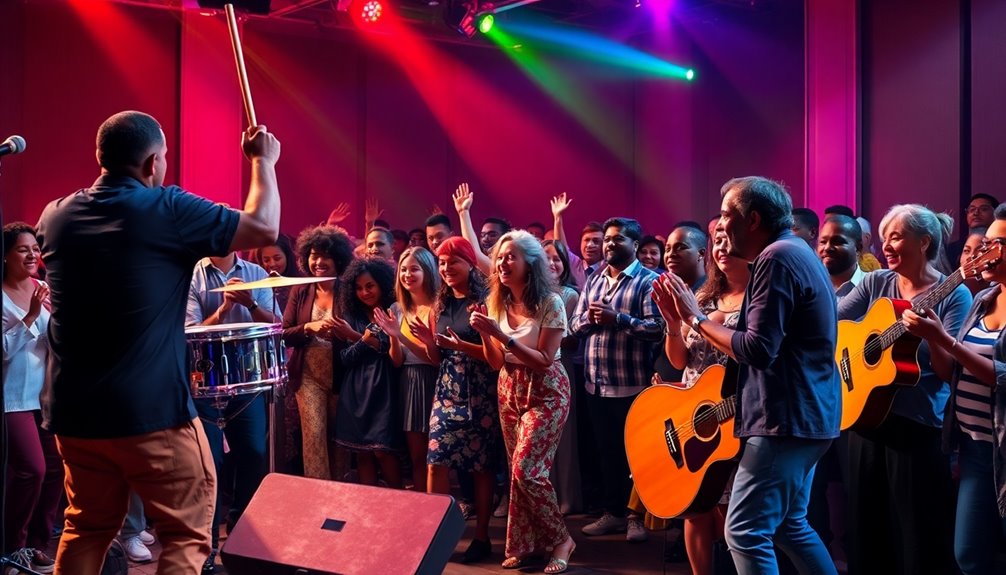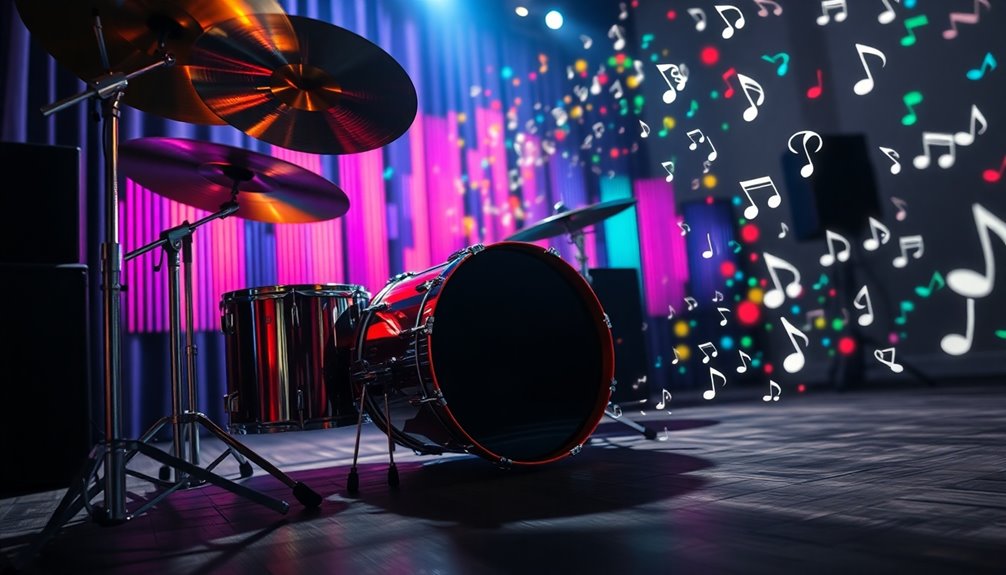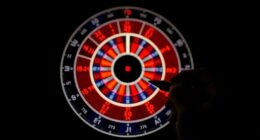Syncopation's all about accenting the normally unaccented beats in music, creating unexpected rhythm and excitement. By altering strong and weak beats, it adds energy and surprise to compositions. This technique reshapes patterns, leading to a more dynamic experience. You'll hear it everywhere—from jazz to pop—engaging listeners and enriching the groove. If you're curious about its historical roots and impact on different genres, you'll find even more fascinating insights as you explore further.
Key Takeaways
- Syncopation emphasizes offbeat rhythms, creating unexpected accents that disrupt the regular pattern of beats, enhancing musical interest.
- "Every other beat is missing" refers to emphasizing weak beats or skipping strong beats, which is a common syncopation technique.
- This rhythmic approach can generate tension and create a unique groove, engaging listeners through surprise and variation in the music.
- Practicing syncopation involves isolating these rhythms and experimenting with layering different patterns for richer texture in compositions.
- Syncopation is prevalent in genres like jazz, funk, and reggae, illustrating its versatility and ability to shape rhythmic identities.
Understanding Syncopation

Syncopation adds a dynamic twist to music by accenting notes that usually go unnoticed. It disrupts typical rhythmic patterns by altering the strong and weak beats indicated by the time signature. Syncopation accentuates normally unaccented notes, which enhances the overall feel of the music.
You'll find that syncopation injects surprise and interest into your music, challenging your expectations of rhythm.
You can explore various types, such as offbeat syncopation, where you emphasize notes between beats, or suspension, which holds a note over a strong beat.
Hemiola creates a brief illusion of a different meter, while missed beat syncopation shifts focus to weaker beats.
This technique is prevalent across genres like jazz, rock, and reggae, enriching your compositions and performances with captivating grooves and rhythms.
Historical Roots of Syncopation

Throughout history, rhythmic innovation has shaped musical expression, and syncopation stands out as a key development. Originating in the Middle Ages, you can trace its influence in Italian and French compositions.
During the Trecento period, syncopation appeared in madrigals by Giovanni da Firenze, while the "Agincourt Carol" showcased its lively use in medieval English music.
Renaissance composers like Giovanni Gabrieli embraced syncopation in both sacred and secular works. Notably, syncopation has been significant since the 14th century, as composers began to employ it in their compositions more frequently.
By the Baroque period, composers such as Bach harnessed it to create tension.
The term itself comes from Medieval Latin "syncopationem," meaning shortening, and Greek "synkopē," meaning cutting off.
This evolution reflects a rich history of rhythmic complexity that laid the groundwork for modern musical styles.
Impact on Musical Genres

While many musical elements contribute to a genre's distinct sound, the role of syncopation is particularly significant. You'll find that genres like jazz and funk thrive on syncopated rhythms, creating an engaging groove that drives the music. In electronic dance music, syncopation adds dynamism, making tracks irresistible on the dance floor. Syncopation introduces emphasizing offbeats that create a unique rhythmic quality in reggae and hip-hop, infusing a unique rhythmic flavor. Even rock and metal bands, like Led Zeppelin and Metallica, use it to deepen their sound. In pop music, syncopation brings catchiness and energy, captivating listeners. Overall, syncopation shapes the character of these genres, enhancing emotional engagement and creating a rich musical experience that keeps you coming back for more.
Compositional Techniques for Syncopation

Understanding compositional techniques for syncopation can elevate your music to new heights. One effective method is suspension syncopation, where you hold a note from a weak beat into a strong beat, creating tension and engaging listeners. Syncopation generates musical interest by accenting weak beats, enhancing the overall emotional impact of the music. Missed beat syncopation, on the other hand, omits a strong beat, emphasizing weak beats and adding drama. Offbeat syncopation shifts emphasis across beats or stresses notes on subdivisions, enriching your rhythmic texture.
To incorporate these techniques, practice active listening to identify syncopated rhythms, study scores to recognize patterns, and use a metronome to maintain steady timing. Isolate syncopated sections for focused practice, and imitate rhythms from songs you admire to inspire your original compositions.
Embrace these techniques to enhance your musical expression!
Performance Dynamics and Expression

Syncopation not only adds rhythmic interest but also profoundly influences performance dynamics and expression. It creates emotional engagement by generating tension through unexpected rhythms, activating your brain's reward system when that tension resolves. As you play, your auditory cortex processes these rhythmic irregularities, while the activation of your motor system encourages movement in response to the engaging patterns. The surprise of syncopation can trigger dopamine release, enhancing your overall musical experience. Moderate syncopation is most effective heightens the sensation of groove, making the music feel more dynamic. By employing dynamic accents and rhythmic variations, you introduce character and a human quality to your performance, ensuring that the tension and release inherent in syncopation resonate deeply with both you and your audience.
Engaging the Audience With Syncopation

How can you keep your audience captivated throughout your performance? One effective way is through syncopation. By altering weak and strong beat patterns, you create unexpected rhythms that surprise your audience and keep them engaged.
Think about songs like "Here Comes the Sun" or "Please Mr. Postman," which use syncopation to draw listeners in. You can apply this principle to your presentations too. Incorporate rhythmic patterns and pauses in your speech to mimic that engaging effect. Research has shown that music therapy can enhance emotional engagement, making your audience more receptive to your message.
Use interactive elements like live polling or audience discussions to add excitement. Even physical props can enhance the experience, making your audience feel like active participants. Fostering engagement and participation is essential for maintaining audience interest and ensuring they feel connected to the material.
Ultimately, introducing surprise elements will keep your audience attentive and invested in what you're sharing.
Rhythm Training and Education

While rhythm might seem like an abstract concept, it's a fundamental aspect of music education that can be taught effectively with the right strategies. You'll establish rhythm fundamentals by teaching patterns of durations, focusing on beat and meter. Repeating rhythms with your students ensures accuracy in tempo and rhythm syllables. Activities like "Beat vs. Rhythm" help them distinguish between the two.
Introduce syncopation basics to emphasize offbeats, allowing for more dynamic rhythms. Using methods like Kodály, Orff-Schulwerk, and Dalcroze Eurhythmics, you can engage students through singing, movement, and percussion. Incorporate rhythm games and practical exercises to enhance their skills, such as rhythm puzzles that involve writing song rhythms on old puzzles for collaborative learning. Flashcards and dictation activities further reinforce their understanding and performance accuracy in rhythm training.
Creative Applications in Composition

Building on the rhythm training concepts already explored, creative applications of syncopation can elevate your compositions significantly. You can use syncopation to create tension and release, much like Bach did in his inventions. Layering different rhythms leads to a polyrhythmic texture that keeps listeners engaged. By disrupting expected patterns, syncopation adds emotional depth, sparking surprise and anticipation. Off-beat accents in your melodies can make them more memorable, enhancing their overall impact. Historically, composers have harnessed syncopation to innovate and captivate, with its roots tracing back to the Renaissance period. Whether in classical, funk, or electronic music, employing this rhythmic device can transform your work, breaking away from predictability and enriching your artistic expression. Experiment with these techniques to deepen your musical narrative.
Improvisation and Syncopation

Improvisation thrives on the dynamic energy that syncopation provides, transforming simple melodies into captivating performances.
In jazz, you emphasize offbeats to craft complex, engaging rhythms, layering different patterns that keep your audience guessing. Syncopation enhances the overall musical experience by adding unexpected elements that intrigue listeners.
Polyrhythmic syncopation, blending various time signatures, creates an unpredictable sound that captivates listeners. This rhythmic complexity evokes emotional responses, building tension and release throughout your performance.
Syncopation's roots in African and Latin American traditions enrich your improvisational style, offering a global perspective.
As you practice, focus on rhythmic exercises and listening to syncopated music to internalize these patterns.
Experimenting with unusual time signatures further enhances your skills, allowing you to express a wide range of emotions from excitement to melancholy in your improvisations.
The Evolution of Syncopation in Modern Music

As syncopation evolved through various musical genres, it became a defining characteristic of modern music, bringing complexity and excitement to compositions.
You can trace its roots back to early classical works and the vibrant rhythms of African and Latin American music. Composers like Bach used syncopation to create tension, while ragtime pianists introduced it to American music.
As you explore jazz, rock 'n' roll, and hip-hop, you'll see how syncopation shapes their rhythmic identities—jazz's swing, rock's unexpected drum fills, and the dropped beats of electronic dance music. Syncopation emphasizes unexpected beats, enhancing listener engagement and fostering creativity, making syncopation a cornerstone of modern music that continues to drive innovation across genres.
Frequently Asked Questions
How Does Syncopation Affect a Song's Emotional Impact?
Syncopation significantly enhances a song's emotional impact by creating tension and surprise that captures your attention.
When rhythms break from the expected pattern, you experience heightened engagement and excitement. This unpredictability triggers dopamine release, making the listening experience more enjoyable.
As you process these complex rhythms, you may feel a range of emotions, from exhilaration to introspection, allowing the music to resonate with you on a deeper level.
Can Syncopation Be Used in Spoken Word Performances?
You might think spoken word needs a steady rhythm, but that's not true!
Syncopation can elevate your performance, adding surprise and depth. By varying the emphasis on certain words or syllables, you create an engaging flow that captivates your audience.
Unexpected pauses and stresses enhance the emotional impact, drawing listeners in.
Embrace syncopation to express yourself uniquely and keep your audience hooked, making your words resonate even more powerfully.
What Are Common Misconceptions About Syncopation?
You might think syncopation is just about complexity, but that's a misconception. It can create monotony if overused. Some link it to negativity, which stems from cultural misunderstandings.
Also, while syncopation can sound dissonant, it's subjective and context-dependent. It isn't limited to specific genres; you'll find it everywhere.
Plus, knowing its various types and proper techniques is crucial for enhancing musicality without causing confusion or disrupting the flow.
How Do Different Cultures Interpret Syncopation?
Imagine you're at a lively salsa dance party, feeling the infectious rhythm.
Different cultures interpret syncopation uniquely. In African music, you'll find intricate rhythms that emphasize off-beats, creating a vibrant atmosphere.
Latin American genres, like salsa, use syncopation to energize dancers.
Meanwhile, Western classical music might employ it to evoke surprise and tension.
Each culture's interpretation enhances its musical experience, inviting you to engage and connect with the rhythm in your own way.
What Tools Can Help in Learning Syncopation?
To learn syncopation effectively, you can use several helpful tools.
Metronomes are great for keeping a steady pulse while you practice. Digital Audio Workstations (DAWs) let you experiment with rhythms, while Ted Reed's Syncopation Book provides structured exercises.
You might also try audio-to-MIDI conversion to recreate patterns. Lastly, online tutorials can guide you through advanced techniques, helping you develop a deeper understanding of rhythmic intricacies.
Conclusion
In exploring syncopation, you've journeyed through its rich history and diverse musical landscapes. Just like a heartbeat that skips a beat, syncopation breathes life into rhythms, adding surprise and excitement. As you embrace its techniques, remember that each offbeat can paint a new musical story, inviting you to express yourself in fresh ways. Whether composing or improvising, let syncopation be the spark that ignites your creativity and transforms your musical voice into something truly unique.









